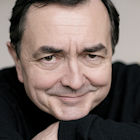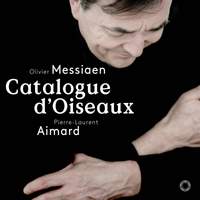Interview,
Pierre-Laurent Aimard on Messiaen's birds
 The French pianist Pierre-Laurent Aimard is widely acknowledged as one of the finest Messiaen interpreters alive today: his discography includes acclaimed recordings of Vingt Regards, Poèmes pour Mi and the Quatuor pour la fin du temps, and he’s the go-to pianist for many of the world’s leading orchestras for large-scale works such as Turangalîla and Couleurs de la Cité Céleste. It’s only recently, however, that he’s begun performing the monumental birdsong-inspired cycle Catalogue d'Oiseaux in public; his recording of the work (his first project on Pentatone) was released in March, and hailed as ‘formidable, scrupulously faithful, unimpeachable’ by Gramophone.
The French pianist Pierre-Laurent Aimard is widely acknowledged as one of the finest Messiaen interpreters alive today: his discography includes acclaimed recordings of Vingt Regards, Poèmes pour Mi and the Quatuor pour la fin du temps, and he’s the go-to pianist for many of the world’s leading orchestras for large-scale works such as Turangalîla and Couleurs de la Cité Céleste. It’s only recently, however, that he’s begun performing the monumental birdsong-inspired cycle Catalogue d'Oiseaux in public; his recording of the work (his first project on Pentatone) was released in March, and hailed as ‘formidable, scrupulously faithful, unimpeachable’ by Gramophone.
I spoke to Mr. Aimard shortly before his recent visit to London to perform Ligeti at the South Bank Centre about his relationships with Messiaen and his wife Yvonne Loriod (who gave the work its premiere in 1959), his experiments with performing the work in different venues and contexts, and why he feels that the Catalogue speaks with even more urgency today than it did sixty years ago.
Messiaen has been central to your repertoire for your entire career - did you deliberately set Catalogue d’oiseaux aside until now?
Absolutely: I waited until a certain point in my life when I thought the time was right. I always feel that with great works of art you can’t just plunge in – there will be a specific moment when you know you’re ready to take them on. It took me until I was fifty to start performing the music of Bach in public; I still haven’t started on the Brahms Second Concerto (but I will start, next year!), and with Catalogue d’oiseaux I put off tackling the entire cycle until I was more or less in my sixties. I thought it needed that kind of space and time, from a humanist and philosophical point of view: that’s my way to live!
In your youth you had close relationships with both the composer and his wife Yvonne Loriod (for whom the cycle was written) – did you ever work directly with either of them on the Catalogue?
Yes, I worked on some of the pieces with each of them, under quite different circumstances: with Yvonne in the framework of her piano class, and with Messiaen in the framework of rehearsal (we also worked on Oiseaux exotiques together, as well as numerous other scores). Being in a position to receive such impressive amounts of knowledge directly from both of them was something quite extraordinary.
In 2016 you performed the entire Catalogue over the course of an entire day (and in various locations, some of them outdoors) at the Aldeburgh Festival – was this close to your ideal scenario for the piece in terms of location and timing?
A sincere Yes! It didn’t come about by luck, of course, but because I was Artistic Director of the Festival! At that stage I’d already played the Catalogue with several colleagues (we’d experimented with splitting it up amongst five of us, three of us, and two of us) and that was an interesting experience – but I’d reached the point where I realised that this music really does need to be played by one single interpreter. When it came to performing the entire cycle, though, it just didn’t make sense to me to present it in a traditional form, so I waited for the opportunity to do it at Aldeburgh - because it’s a unique festival, because I’d already worked there for eight years, and because I had a marvellous team supporting me! And it was an exceptional place for realising this piece: I’ve done it in other formats and with other partners since then (and will do so again!) but this performance had such a strong impact, and I truly felt that it was one of the most enlightening and overwhelming days in my life.
Do you have plans for further al fresco performances?
Yes, in fact I’ve since performed it at the Tanglewood and Ravinia Festivals, and most recently at the Cité de la Musique in Paris; in June I’ll do it at the Concertgebouw, and then in Frankfurt at the Alte Oper and various other (indoor) venues in 2019. But I do schedule this piece with particular care - it’s not the kind of music that you can perform three times a week!
At risk of sounding slightly trite, how central has direct contact with the natural world been in terms of your relationship with this music?
To me, one's own contact with nature is an integral part of who you are as a human being, and of course as an interpreter. In my early years (particularly when I was a teenager) I spent a lot of time trying to put myself into this space, and a lot of that was due to my contact with Messiaen – through him I realised how much I needed to experience what it is to go into nature, to be present in the moment, to listen to birdsong and to understand the different ways of listening to and expecting these musical events. So yes, immersion in nature was an intrinsic part of my education, both as a human being and a musician.
In your foreword to the recording, you make a powerful reference to the contemporary 'consternation about the way the world is being destroyed by man': has the experience of working on this music made you feel more strongly about this issue?
I think it's something which everybody comes to feel more strongly about when they hear this piece. Over the course of the thirty or forty years that people have been listening to this music (forty-five years in my own case!), I’ve noticed a pronounced change in audiences’ response to it, not just because people have become more familiar with its language, but because our relationship with nature has changed so drastically: the urgency which people now feel for contact with nature is strengthened by the ever-escalating destruction of our planet. I was at a conference recently on this subject, and there were some ornithologists there who said that one of the important dimensions of the piece today is that it enables to you listen to the song of one third of the birds that have now vanished entirely from our country - so for them the work itself bears important witness to a disappearing world.
How influential do you feel the Catalogue has been on subsequent composers?
It’s a difficult question! Certainly Messiaen had a strong influence on many other composers in terms of his work on time, on rhythm and colour, on orchestration - but I don’t know how influential the Catalogue d’oiseaux in particular has been. If anything, I think it's had less influence than a lot of his other works. When Messiaen made significant discoveries on rhythm or colour, he would often present a kind of compositional or theoretical statement explaining himself – he was a pedagogue to the entire world before being a pedagogue for his students. But it’s very different in the case of Catalogue d’oiseaux, where I think he actively doesn’t want to make a statement. It’s not a demonstration-piece: it’s more a pièce résurgée, a piece where a despairing man, lost in his dark private life, tries to find a home in nature. It’s the work of a man who needed to be in his own time and space, to renew his musical language: to me, the composer of Catalogue d’oiseaux is an isolated poet rather than a pedagogue, and I think that consequentially he was less influential here than in works like the Études de rythme or Livre d’Orgue, or the ‘colour-pieces’ like Couleurs de la Cité Céleste.
Pierre-Laurent Aimard's recording of Catalogue d'oiseaux was released on Pentatone on 30th March.
Available Formats: 3 SACDs, MP3, FLAC, Hi-Res FLAC
Messiaen: Couleurs de la Cité Céleste & Bruckner: Symphony No. 8
Pierre-Laurent Aimard (piano), London Symphony Orchestra, Sir Simon Rattle
The London Symphony Orchestra's Couleurs de la Cité Céleste (with Aimard as soloist) was recorded live at the Barbican in April 2016 and is released tomorrow on the orchestra's own label.
Available Format: DVD Video + Blu-ray




